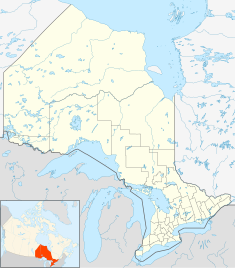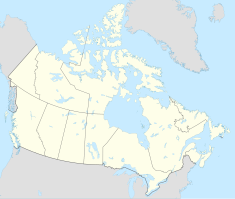| Fort Wellington | |
|---|---|
 Fort Wellington's blockhouse and latrine from the southwest, 2006 | |
| Location | Prescott, Ontario, Canada |
| Coordinates | 44°42′46″N 75°30′31″W / 44.7129°N 75.5085°W |
| Built | 1813–1814[1] |
| Original use | Military fortification (1813–14; 1838–1923) |
| Rebuilt | 1838–1839[1] |
| Architect | George R. J. Macdonnell and Thomas Pearson (first fort)[1] |
| Governing body | Parks Canada |
| Website | pc.gc.ca/en/lhn-nhs/on/wellington/index |
| Official name | Fort Wellington National Historic Site of Canada |
| Designated | 30 January 1921 |
Fort Wellington National Historic Site is a historic military fortification located on the north shore of the St. Lawrence River at Prescott, Ontario. The military fortification was used by the British Army, and the Canadian militia for most of the 19th century, and by the militia in the 20th century, until 1923, when the property was handed over to the Dominion Parks Commission, the predecessor to Parks Canada. The fort was earlier named a National Historic Site of Canada in January 1920.[1]
Built in the midst of the War of 1812, the British commissioned the construction of the fortification in 1813 to protect the head of the Gallop Rapids in the St. Lawrence. Completed in 1814, the fort was abandoned by the British shortly after the war, although it formally remained the property of the British Board of Ordnance. The British commissioned the construction of a new fort, on top of the earthwork of the first fort in 1838, during the onset of the Rebellions of 1837–1838. Completed in 1839, the fort was used by the British Army, and the Canadian Militia.
The fort was used by the British until 1863, when British units left the area, making the militia the fort's sole occupant. The militia continued to use the fort until 1923, when it handed over the property to the Dominion Parks Branch, the predecessor to Parks Canada. As a National Historic Site, Fort Wellington operates as a historical open-air museum.
- ^ a b c d "Fort Wellington National Historic Site of Canada". HistoricPlaces.ca. Parks Canada. 2019. Retrieved 22 May 2019.


